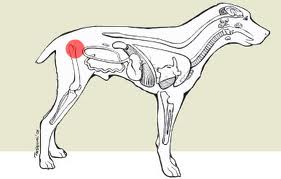Canine hip dysplasia is a common skeletal disease. It occurs when the hip joints – the ball and socket – fail to develop normally. The hip joint then deteriorates over time, leaving it unable to function. Canine hip dysplasia is a genetic disease that requires multiple genes to be present in order it to manifest. It primarily affects large breed dogs such as Labrador retrievers, German Shepherds, Saint Bernards and Great Danes.
Canine hip dysplasia has an early onset. It occurs when the dog is still maturing, typically at about four months of age. If a dog has canine hip dysplasia, he will show signs of the disease by age 2. The hips are typically normal at birth. In 7% of cases, only one leg will be affected, with the rest of the cases occurring in both legs.
Symptoms
Signs of canine hip dysplasia involve motion and stiffness in the dog. If the dog has difficulty rising, running or jumping, then hip dysplasia may be present. A narrow stance in the legs, bunny-hopping movement, limping, decreased activity, pain and loss of muscle mass are also signs characteristic of hip dysplasia.
Diagnosis
A veterinarian will do a physical exam on your dog and order blood work, a urinalysis and an electrolyte panel. You should provide the vet with information about when the symptoms started and if any injuries could have been a factor. If your dog is a purebred, provide your vet with any information about the dog’s lineage. It will help determine if there is a genetic factor.
X-rays will also be performed. If canine hip dysplasia is the cause of the symptoms, evidence of joint problems will show up in the X-rays.
The Orthopedic Foundation for Animals has information about how a dog’s hips are graded and hat you should looking for in your dog’s hip X-rays.
Treatment
The main goals of treatment are to restore limb function and alleviate pain. Conservative and surgical treatments are available for canine hip dysplasia. Conservative treatment includes weight management, exercise and pain relievers. Conservative treatment focuses on building muscle mass through moderate exercise, such as swimming and walking. Jumping and fetching should be avoided, as these activities put added pressure on the joints.
There are three surgical procedures available for dogs with hip dysplasia. The hip joint can be reconstructed in young dogs with minimal evidence of dysplasia. Once the dysplasia becomes degenerative, there are two other options available. One is the removal of the femoral head and neck. This works best for small dogs (under 30 pounds) with evidence of dysplasia in only one hip. A total hip replacement is offered as a last resort. It is the only form of treatment that can restore normal hip function in a dog. It can be done to just one or both legs. The success rate of a hip replacement is 91%.
The type of treatment your vet will recommend will depend on the age of the dog, severity of the hip dysplasia and the owner’s financial situation. Up to 60% of dogs respond to conservative therapy over time. The rest, up to 40%, may require surgery.
Managing hip dysplasia
Follow up with the vet to ensure that there are no changes in your dog’s hip dysplasia. X-rays will be taken and compared to the previous ones. The vet may recommend a special diet if your dog is overweight. You should not breed such dogs and their parents, as the condition can be passed on to the puppies.
